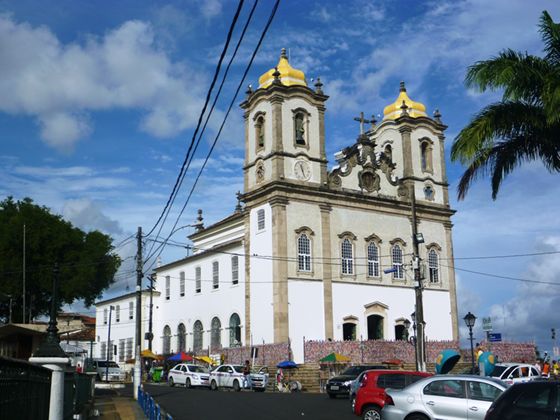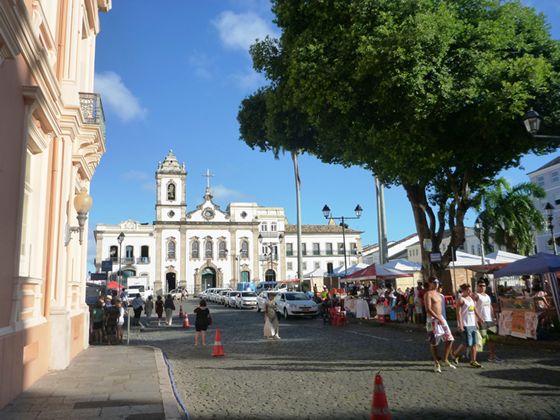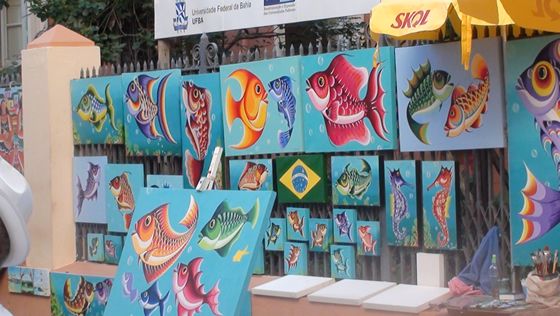Salvador, West Africa?

Wednesday February 26th , 2014 South Atlantic Ocean – off Brazil – STILL!!! , 02 05.2S 39 24.1W Today's Blog by David (Time zone: UTC – 3.0) With 3.5 million slaves having arrived from the West Coast of Africa in Bahia, there is a clear if not dominant African influence in Salvador. Now, here is another gap in my history education. I had previously no real conception of the scale of slavery which it seems was a very profitable trade – for the owners at least – but the rate of attrition was huge. Many (perhaps 10%) were killed in the process of capture and transport to the coast, or while they were corralled ashore in the barracoon awaiting their ship. They were then stowed on the “Slave Deck”. The slave deck was a set of gratings covering the whole space set aside for perhaps 500-600 slaves and let the air into that space; and they sat, or squatted, on the floor about two or two and a half feet under the grating usually in rows running athwartships, the men forward, chained in pairs, and the women aft. They could not sit upright nor stand. The voyage to Brazil would have taken perhaps a month. Once out of sight of land they were let out in groups during the day for exercise but otherwise that sat in their own excrement. Some ships turned the pumps on the filth each mooring; others made the slaves clean up other own mess and then wash, on deck, stark naked, in vinegar and water. Even so, a slave ship could be smelt passing by anyone within a mile or so downwind of her. Once they set sail, once the sea sickness abated, dysentery set in. That, combined with malaria, typhoid, beatings starvation etc. led to a further 35% dying before arrival in the Americas.1 Therefore, quite possibly, 7 million Africans were enslaved to deliver the 3.5million that arrived in Bahia alone, quite apart from those that were exploited in the West Indies and North America……. Even with such losses on passage, the profits were so great it was not considered worth making the conditions any better for their cargo. The slavers became very wealthy. And it is clear that the Slavers and the general populationsaw nothing wrong in it – indeed they prided themselves for it. It is said that one slaver ship owner who prayed for a good passage (prayed/preyed? Hmmm.) promised God that he would build a church if his voyage was successful. And he did:
The famous Bonfim Church, Salvador
In which no expense appears to have been spared – and all paid for out of the profits of slavery. There are more churches in Salvador than you can shake a stick at – so it seems – the interiors are lavishly decked in Gold and beautiful carvings and sculptures. This one in the main Pelourinho Square on the Salvador Old Town was never finished. …. ` Our Lady of the Blacks, Pelourinho Square [It is said that the right hand tower was never built in order to avoid “land taxes” which were levied only on completed buildings. Now where have I heard that before? ] Brazil has the largest population of practising Catholics in the world – it is said 80% of the population are practising today, although, as ‘most everywhere, that percentage is declining. In addition to Catholicism, the Portuguese also brought the customary repression of other religions and beliefs including their version of the Inquisition. Those of the slaves who survived the passage (presumably the strongest) brought with them their African Culture and beliefs. These were incompatible with Catholicism, driving the African culture underground. To cut a long story short, in Brazil they integrated into Catholicism, widening and creating new ways of worshipping their African deities whilst purporting to be worshiping god. ` This ‘religious syncretism’ is one of the most striking features of Salvador’s matrix religions, characterised by the fusion of the different cultural and ethnic aspects. In Bahia, an area dominated by Yoruba and Bantu tribes from West Africa, Africans brought the practice of orisha worship. These gods represent the fundamental elements: earth, fire , water and air. Some groups aligned these orishas with up to nine Christian saints - who also happened to be black – and developed a religion now known as “Candomblé ” based upon their home belief systems. Pretending to worship those catholic saints served as a refuge for blacks to disguise but continue to practice their own faith. Today, “Candomblé is above ground and is practiced in their own Houses of Worship. Candomblé dominated much of our daily experiences in Salvador – in many ways, the people, their traditional clothing, the art – even the souvenirs are reminiscent of Africa.
Another example of how the slaves camouflaged their activities can be found in their ‘Capoeria’ – this is really quite impressive, and attractive, street dancing , involving quick kicks, jumps and swerves which actually is a developed and efficient martial art – developed clandestinely to entertain their slave masters, the real skill in the dancing is to conduct the moves WITHOUT hitting your opponent.
Capoeiria in Salvador Finally, and admittedly a bit off subject, the drums and drumming pays a big part in Bahian life. We encountered street bands either comprising only drums or sometime with whistles and trumpets everywhere we went – and they are noisy!
Children drummers and dancers in Pelourinho, supported by the Olodum Charity Note 1 My source for this description was Patrick O’Brian’s descriptions in his book The Commodore, from the Master and Commander series. He is described as the greatest historical novelist of all time ….. so it must be right then. 2 Errr…. That’s all folks. |






